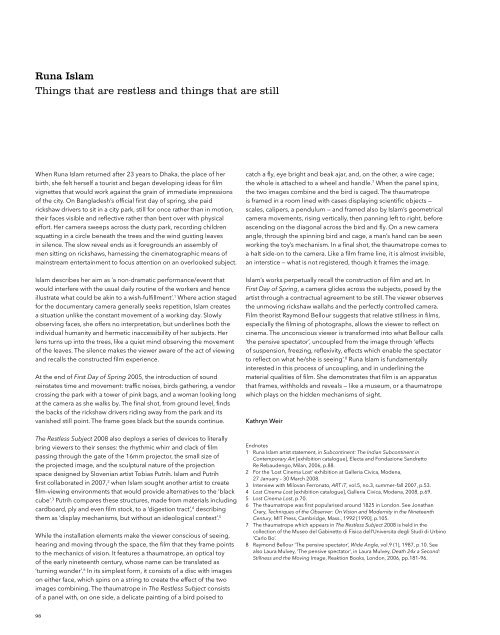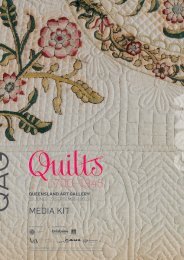Queensland Art Gallery - Queensland Government
Queensland Art Gallery - Queensland Government
Queensland Art Gallery - Queensland Government
You also want an ePaper? Increase the reach of your titles
YUMPU automatically turns print PDFs into web optimized ePapers that Google loves.
Runa Islam<br />
Things that are restless and things that are still<br />
When Runa Islam returned after 23 years to Dhaka, the place of her<br />
birth, she felt herself a tourist and began developing ideas for film<br />
vignettes that would work against the grain of immediate impressions<br />
of the city. On Bangladesh’s official first day of spring, she paid<br />
rickshaw drivers to sit in a city park, still for once rather than in motion,<br />
their faces visible and reflective rather than bent over with physical<br />
effort. Her camera sweeps across the dusty park, recording children<br />
squatting in a circle beneath the trees and the wind gusting leaves<br />
in silence. The slow reveal ends as it foregrounds an assembly of<br />
men sitting on rickshaws, harnessing the cinematographic means of<br />
mainstream entertainment to focus attention on an overlooked subject.<br />
catch a fly, eye bright and beak ajar, and, on the other, a wire cage;<br />
the whole is attached to a wheel and handle. 7 When the panel spins,<br />
the two images combine and the bird is caged. The thaumatrope<br />
is framed in a room lined with cases displaying scientific objects —<br />
scales, calipers, a pendulum — and framed also by Islam’s geometrical<br />
camera movements, rising vertically, then panning left to right, before<br />
ascending on the diagonal across the bird and fly. On a new camera<br />
angle, through the spinning bird and cage, a man’s hand can be seen<br />
working the toy’s mechanism. In a final shot, the thaumatrope comes to<br />
a halt side-on to the camera. Like a film frame line, it is almost invisible,<br />
an interstice — what is not registered, though it frames the image.<br />
Islam describes her aim as ‘a non-dramatic performance/event that<br />
would interfere with the usual daily routine of the workers and hence<br />
illustrate what could be akin to a wish-fulfillment’. 1 Where action staged<br />
for the documentary camera generally seeks repetition, Islam creates<br />
a situation unlike the constant movement of a working day. Slowly<br />
observing faces, she offers no interpretation, but underlines both the<br />
individual humanity and hermetic inaccessibility of her subjects. Her<br />
lens turns up into the trees, like a quiet mind observing the movement<br />
of the leaves. The silence makes the viewer aware of the act of viewing<br />
and recalls the constructed film experience.<br />
At the end of First Day of Spring 2005, the introduction of sound<br />
reinstates time and movement: traffic noises, birds gathering, a vendor<br />
crossing the park with a tower of pink bags, and a woman looking long<br />
at the camera as she walks by. The final shot, from ground level, finds<br />
the backs of the rickshaw drivers riding away from the park and its<br />
vanished still point. The frame goes black but the sounds continue.<br />
Islam’s works perpetually recall the construction of film and art. In<br />
First Day of Spring, a camera glides across the subjects, posed by the<br />
artist through a contractual agreement to be still. The viewer observes<br />
the unmoving rickshaw wallahs and the perfectly controlled camera.<br />
Film theorist Raymond Bellour suggests that relative stillness in films,<br />
especially the filming of photographs, allows the viewer to reflect on<br />
cinema. The unconscious viewer is transformed into what Bellour calls<br />
‘the pensive spectator’, uncoupled from the image through ‘effects<br />
of suspension, freezing, reflexivity, effects which enable the spectator<br />
to reflect on what he/she is seeing’. 8 Runa Islam is fundamentally<br />
interested in this process of uncoupling, and in underlining the<br />
material qualities of film. She demonstrates that film is an apparatus<br />
that frames, withholds and reveals — like a museum, or a thaumatrope<br />
which plays on the hidden mechanisms of sight.<br />
Kathryn Weir<br />
The Restless Subject 2008 also deploys a series of devices to literally<br />
bring viewers to their senses: the rhythmic whirr and clack of film<br />
passing through the gate of the 16mm projector, the small size of<br />
the projected image, and the sculptural nature of the projection<br />
space designed by Slovenian artist Tobias Putrih. Islam and Putrih<br />
first collaborated in 2007, 2 when Islam sought another artist to create<br />
film-viewing environments that would provide alternatives to the ‘black<br />
cube’. 3 Putrih compares these structures, made from materials including<br />
cardboard, ply and even film stock, to a ‘digestion tract’, 4 describing<br />
them as ‘display mechanisms, but without an ideological context’. 5<br />
While the installation elements make the viewer conscious of seeing,<br />
hearing and moving through the space, the film that they frame points<br />
to the mechanics of vision. It features a thaumatrope, an optical toy<br />
of the early nineteenth century, whose name can be translated as<br />
‘turning wonder’. 6 In its simplest form, it consists of a disc with images<br />
on either face, which spins on a string to create the effect of the two<br />
images combining. The thaumatrope in The Restless Subject consists<br />
of a panel with, on one side, a delicate painting of a bird poised to<br />
Endnotes<br />
1 Runa Islam artist statement, in Subcontinent: The Indian Subcontinent in<br />
Contemporary <strong>Art</strong> [exhibition catalogue], Electa and Fondazione Sandretto<br />
Re Rebaudengo, Milan, 2006, p.88.<br />
2 For the ‘Lost Cinema Lost’ exhibition at Galleria Civica, Modena,<br />
27 January – 30 March 2008.<br />
3 Interview with Milovan Ferronato, ART iT, vol.5, no.3, summer–fall 2007, p.53.<br />
4 Lost Cinema Lost [exhibition catalogue], Galleria Civica, Modena, 2008, p.69.<br />
5 Lost Cinema Lost, p.70.<br />
6 The thaumatrope was first popularised around 1825 in London. See Jonathan<br />
Crary, Techniques of the Observer: On Vision and Modernity in the Nineteenth<br />
Century, MIT Press, Cambridge, Mass., 1992 [1990], p.105.<br />
7 The thaumatrope which appears in The Restless Subject 2008 is held in the<br />
collection of the Museo del Gabinetto di Fisica dell’Universita degli Studi di Urbino<br />
‘Carlo Bo’.<br />
8 Raymond Bellour ‘The pensive spectator’, Wide Angle, vol.9 (1), 1987, p.10. See<br />
also Laura Mulvey, ‘The pensive spectator’, in Laura Mulvey, Death 24x a Second:<br />
Stillness and the Moving Image, Reaktion Books, London, 2006, pp.181–96.<br />
Runa Islam<br />
Bangladesh/United Kingdom b.1970<br />
The Restless Subject (still) 2008<br />
16mm film and CD wild tracks, colour, sound,<br />
6:42 minutes / Image courtesy: The artist and<br />
White Cube, London / Photograph: Todd-White<br />
<strong>Art</strong> Photography<br />
First Day of Spring (still) 2005<br />
16mm film, colour, sound, 7:00 minutes / Image<br />
courtesy: The artist and White Cube, London /<br />
Photograph: Todd-White <strong>Art</strong> Photography<br />
98 99
















